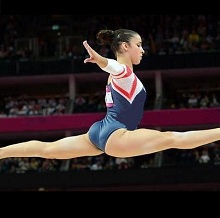“Poise” is defined as “…a state of balance or equilibrium; stability.”
Poise is a fluid state of balance and coordination in movement. Human bodies were originally designed in Paleo time for poised, balanced, and coordinated movement.
Anthropologist Dr Raymond Dart describes poise as: “…using muscle balance and coordination…and timing, as well as gravity, to optimum advantage. Integration of these elements results in…performance which is easy, graceful, satisfying and effective.”
US Olympic gymnast Jordyn Wieber displays poised, balanced motion in this photo taken at the 2012 London Olympics.
Chronic stress, poor posture and activities such as sitting and using a computer have caused modern folks to lose the balance, coordination and poise
that enabled Prehistoric ancestors to survive.
Habitual movements and stress responses keep our muscles tensed and shortened, and cause our body to release stress hormones that put us in a continual “fight or flight” mode.
Regular practice of the Alexander Technique helps to restore our original poise, with better muscular/skeletal balance and coordination. We learn to become aware of our bodies and to mindfully recognize and change stress responses and habitual behaviors that increase stress and pain reactivity.
We can “unlearn” habits of tension in basic activities such as texting, walking, standing, sitting, and using a computer.
Note: MAT is not medical treatment or therapy; it is an educational health and wellness practice.
Photograph of Jordyn Wieber courtesy of Jordyn Wieber and Facebook.

